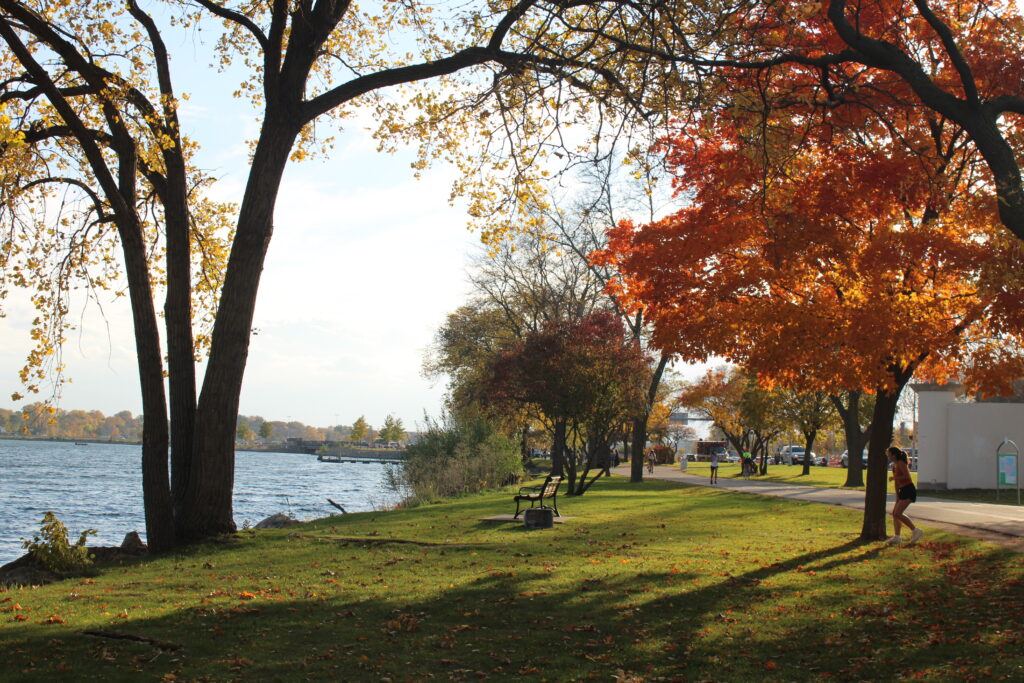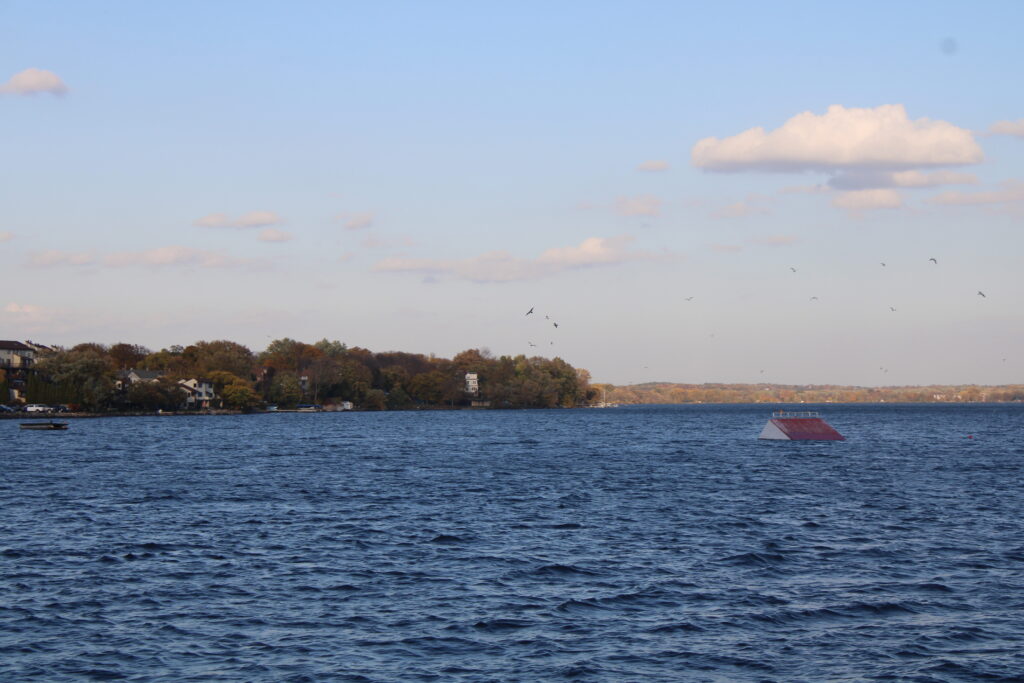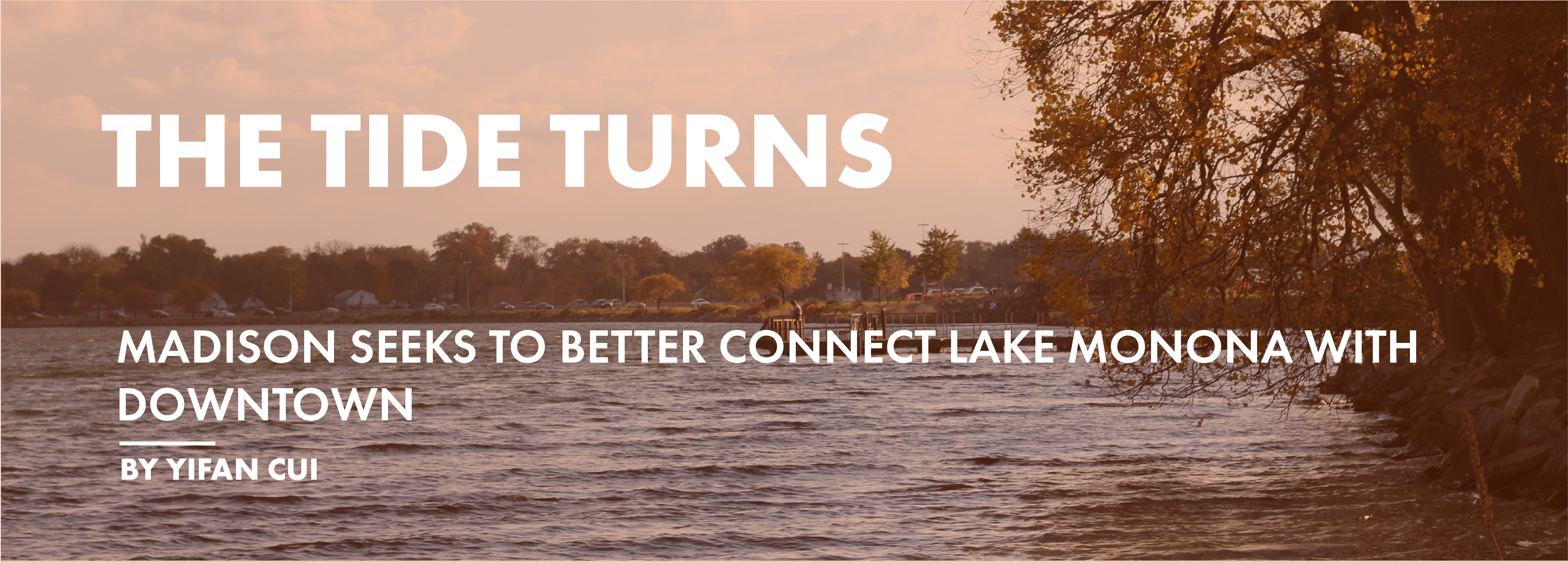Under the golden hues of a Wisconsin sunset, Lake Monona stretches out, its serene waters an integral part of Madison’s identity.
These beloved waters, cherished over thousands of years by the Ho-Chunk people, have stood the test of time. In many ways, they’ve been the same for hundreds of years.
Now, a transformative endeavor is underway to unite the people of Madison with the lake, an ecologically vibrant area often separated by a bustling traffic artery. The new project has the potential to create a thriving civic space, bridging the east and south side communities to the water, fostering shared activities and uniting the city.
This project has immense significance, not only for downtown but for the entire city, connecting generations and uniting a community through the lake.
“It’ll just be a place that everybody can enjoy and one of the really special places in Madison,” says Allen Arntsen, chair of the Lake Monona Waterfront Ad Hoc Committee.

A tapestry of nature and life
Lake Monona plays a pivotal role in the lives of Madison residents. Each day, as the sun rises over the wooded edge of the lakeshore, the shores come alive. Traffic rushes along John Nolen Drive while cyclists and joggers weave through lakeside paths. Residents gather along the water’s edge to enjoy fishing, boating and moments of respite.
However, a palpable separation persists, one that hinders the complete connection between the city and the lake.
Madison Common Council District 4 Alder Michael Verveer hopes to change that.
“I live only a couple of blocks from Lake Monona … It’s a tremendous resource,” Verveer says. “But, frankly, sometimes, especially during rush hour traffic, you have to take your life into your own hands to cross or bike across the roadway.”
In 2012, the nonprofit organization Friends of Nolen Waterfront was founded with the aim of enhancing community access to Lake Monona and encouraging its development to its fullest potential. Verveer collaborated with the group to secure initial funding and proposed a budget amendment to initiate the Lake Monona Waterfront Project.
In February 2022, Madison’s Common Council approved a design competition to create a master plan that will be implemented in several phases. Co-sponsored by the City of Madison and Friends of Nolen Waterfront, the three selected finalists received $75,000 to develop a conceptual master plan.
The committee then picked Sasaki, an interdisciplinary planning and design firm, to create the master plan with an initial budget of $200,000. The project aims to transform a 1.7-mile stretch of the lake’s shoreline into four distinct zones.
“With this new project, we can write some of those drawings and create a great civic space,” says Jason Ilstrup, the president of Downtown Madison Inc., a nonprofit advocacy organization focusing on the revitalization of the downtown area.
The project’s four zones include Law Park Ledge, Lake Lounge, Community Causeway and Olin Overlook. Highlights include an elevated park, an amphitheater, a boathouse and nature center.
Verveer says the plan aims to craft areas for people to come together, whether for organized events or casual gatherings, offering a vibrant hub for community engagement. Arntsen pointed to fishing tournaments and waterskiing groups as examples of ways Madisonians enjoy the lake.
“You can bring your kids and stick your feet in the water, walk in the lake, sit along the lake,” Arntsen says.
At the beginning of the new year, Verveer will present the master plan to be reviewed by the city council and various committees, aiming for adoption by early 2024. The initial phase is scheduled for 2025 and 2026, coinciding with federal funding for the John Nolen Drive causeway bridge reconstruction
“No longer will motor vehicles, bicycles, pedestrians, runners and walkers be literally within a few feet of moving vehicles on the bridge that connects south Madison to downtown Madison across Lake Monona,” Verveer says. “They will be segregated in a very safe and green way.”

Needs and challenges
The natural shoreline played a pivotal role in Madison’s city planning. The area along Lake Monona remained unrealized, leaving the area transformed into parking lots, a highway and railroad tracks.
In the late 20th century, the construction of the Frank Lloyd Wright-designed Monona Terrace Convention Center marked a turning point. Entering into the 21st century, city public and private endeavors aimed to bridge downtown Madison to Lake Monona, creating a signature lakefront park.
During the competition phase, an open survey yielded more than 8,000 comments. Through this exhaustive community engagement, project planners found themes emerging and began reintegrating the community’s ideas into the evolving design.
“They really put the environment, the lake and the water quality front and center,” Arnsten says. “They also had a very strong emphasis on the cultural history of the site, especially the Ho-Chunk Nation, which was a prominent gathering place. And they reached out significantly to the Ho-Chunk Nation to get their input.”
However, the grand vision is not without its share of challenges and community needs. Residents have expressed concerns about the master plan, including potential obstructions to views from homes on East Wilson Street and safety issues at the intersection of South Broom Street, John Nolen Drive and North Shore Drive. Efforts are underway to address these concerns, such as proposing an underpass instead of a bridge to alleviate conflicts.
Arnsten explains navigating the project involves overcoming significant challenges in connecting across the railroad tracks and John Nolen Drive. It’s a busy transportation corridor, accommodating train routes, daily traffic volume of 40,000 cars and serving as a critical juncture for two major city bike paths. Balancing various transportation demands is a key consideration, and planners have listened to public input, Arnsten says.

A greener vision
The project is dedicated to enhancing Lake Monona and the city’s sustainability.
One concern is stormwater from rain, snowmelt and ice runoff that can directly enter the lake, Verveer says. Despite the perception of cleanliness in the Lake Monona area, this stormwater may contain contaminants such as phosphorus from leaves, urban pollutants and winter salt treatment.
The Clean Lakes Alliance works to champion lakes and watershed stewardship, through education programs and top runoff reduction in agricultural and urban areas. The organization is an alliance of experts in lake health and sustainability to help refine the plan it championed and led.
For example, James Tye, the founder and executive director of the Clean Lakes Alliance, says the group will focus on reevaluating areas to include balanced transportation and designed landscape elements, such as native plants, floating beds and native rice.
“We could look toward and learn from our past when the Ho-Chunk were the predominant culture and take some of those ideas and bring them into the present day,” Tye says.

A collective effort
The Lake Monona Waterfront Project is a testament to collaboration. Diverse parties and interests have rallied together, investing resources, energy and funds to realize the project’s full potential. Partnerships with organizations like the Ho-Chunk Nation and the Clean Lakes Alliance exemplify the shared commitment driving this initiative.
The most substantial challenge in the later phases of implementation will be funding the project, Verveer says. Implementing all facets of the plan will necessitate substantial support from the private sector, including private fundraising.
“The actual implementing, building the park is a challenge,” Arnsten says. “It’s a big lift, but it’s worth figuring out how to build and pay for it.”
Verveer is optimistic that the enthusiasm for the project, even among local philanthropists and those with financial resources, will help bring the plan to life.
“It’s not like just some distant pipe dream or a grand design,” Verveer says. “There is a lot of excitement and momentum.”
The master plan offers a long-term vision for lakeshore improvements, but there isn’t immediate funding for construction. Implementation will likely be phased over decades, contingent on funding availability from federal, state and local private sources. An initial step is a $2.5 million request for causeway improvements in 2026, aligning with the John Nolen Drive reconstruction project managed by the city.
However, designers and advocates remain optimistic.
“It’s a once-in-a-generation opportunity,” Verveer says. “It will be a real jewel for the city if even a small portion of the ideas discussed come to fruition.”
